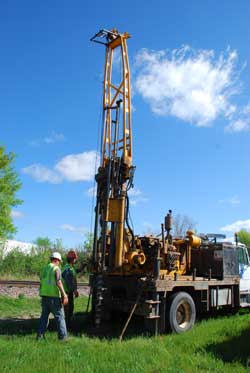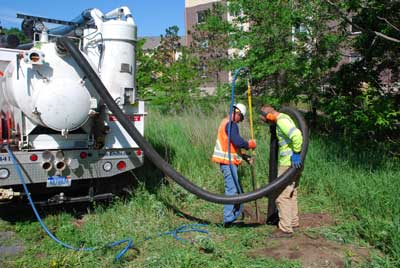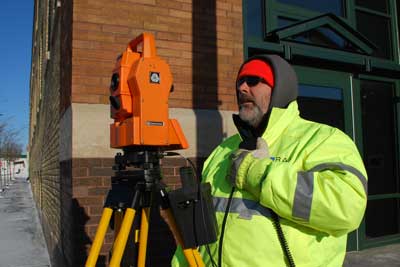From Extending Tracks, the Southwest LRT Project Newsletter, issue 6 (Summer 2014).
Fieldwork underway
Crews are doing a variety of fieldwork on the Southwest LRT Project over the summer and fall for environmental documentation and engineering work. Some field work is a continuation of work begun last year.
While staffers will notify property owners directly if crews need to obtain right-of-entry permits to access their lands, the general public and neighbors may wonder what is happening.
The following pages explain the types of field work being done, why it is being done and what the public can expect to see.
Geotech borings
 Who: Two-person crews are conducting the soil borings. A surveyor may accompany each drilling crew.
Who: Two-person crews are conducting the soil borings. A surveyor may accompany each drilling crew.
What: Geotech borings are soil borings using a drilling machine with a hydraulic auger on the back of a truck. The borings are about a foot in diameter and can go as deep as 20 to 100 feet. If discovered, contaminated soil will be taken to certified landfills. Uncontaminated soil will be returned to the hole. All holes will be refilled and seeded the same day or patched with asphalt the same day if they were originally paved. Soils range from sandy in the Kenilworth Corridor to clay and peat in Eden Prairie.
When: Weekdays. Work will intensify in spring 2014 and occur throughout 2015 during daytime hours.
Where: Crews will bore holes along the center line of the Southwest LRT route near existing or proposed foundations of the line’s future and existing bridges and tunnels. Twenty-foot borings are typically drilled along the center line of the proposed light rail, railroad tracks or roadways while 100-foot deep borings are drilled around proposed tunnels, bridge abutments and bridge piers. Most properties, particularly along the western portion of the project, will need boring work conducted.
Why: Borings help determine soil types and depth of the water table to inform engineers how to design bridges, tunnels, roads, track and trails. Engineers will use the information to determine if they need to compact soft soils so the ground can support the weight of station platforms and the operations and maintenance facility or if they need to remove or mitigate soils prior to construction.
Subsurface utility exploration
 Who: Two- to three-person crews. A surveyor will accompany each utility locating crew.
Who: Two- to three-person crews. A surveyor will accompany each utility locating crew.
What: Work includes coordinating with freight railroads and Gopher State One Call to mark the location of underground utility lines with spray paint and/or flags. Surveyors record the markings. Utility locating crews use vacuum trucks to remove soil above the utility within 18-inch-by-18-inch potholes. Once the utility line has been found, the subcontractor will replace and compact the removed soil. The work also includes opening manholes to observe the location of storm sewer and sanitary sewer lines.
When: Weekdays through end of 2014 during daytime hours.
Where: Subsurface utility exploration is conducted at specific locations where utilities cross the proposed LRT guideway.
Why: To identify the location of storm and sanitary sewer and water lines, fiber optics, other pipelines such as natural gas that cross the proposed LRT guideway and to verify utility information provided by private utility companies, cities’ public works departments, railroads and other agencies. Engineers use the information to determine if the utility lines will be affected by the proposed LRT design.
Surveying
 Who: Surveyors.
Who: Surveyors.
What: One surveyor will use a tripod with a computerized surveyor recorder (known as a total station) or one person will use a tripod pointed toward another person with a survey rod.
They can use GPS to verify elevations and locations of topographic features such as walls, trails, roads, track, utilities and/or structures.
When: Surveying will be finished in 2014.
Where: The entire Southwest LRT route.
Why: To aid engineers in their design of roads, tracks, bridges, tunnels and trails by determining property lines, verifying topography, recording utility locations and verifying or identifying easements.
Wetland surveying
Who: Surveyors.
What: Crews access the property to examine soil and plant types and use GPS technology to take survey points and delineate the wetlands area.
Crews are granted right-of-entry to the land by first coordinating through Southwest Project Office community outreach staff and property owners. The property owner is contacted by email, phone or a letter outlining the work details and the schedule. Once an agreement is signed, the property owner is contacted to coordinate entry.
When: Survey work could begin in June 2014 depending on how soon workers are granted access to the properties. It would be completed in the summer of 2014.
Where: The remaining wetland survey work includes: an area along a road near the UnitedHealth Group Inc. campus in Minnetonka; and an area near the crossing of a wetland north of Smetana Road along the Minnetonka/Hopkins border. The work involves an access road to the wetland area.
These sites were identified to complete survey work on adjustments made to the alignment since initial delineations were completed in the fall of 2013.
Why: To identify and assess the wetland resources along the Southwest LRT alignment. The survey findings are used to avoid, minimize or mitigate the project’s impact on any wetlands.
Field title verification
Who: Minnesota Department of Transportation right-of-way employees will do the field title work for the Southwest LRT Project. Some of the work may be done over the phone with property owners; other visits may include in-person meetings with the owners.
What: Staff earlier compiled the legal titles for hundreds of parcels along the SWLRT alignment. The number of impacted properties – meaning that SWLRT will require all or part of the property – is 138. The titles show the property’s owner(s) and easement information.
MnDOT staffers verify the title information with land owners and provide a parcel sketch that provides an estimate of the project’s impact to the land. Property owners are also provided booklets that discuss the acquisition process and relocation assistance process, if they are eligible. There are no single-family homes being taken by the project.
The field title visit won’t be the first time property owners have heard that the project is impacting their property. Many have talked previously with staff from the project office, including MnDOT representatives.
During the field title meetings, staff may also begin collecting information needed for the relocation process, if required, including taking pictures and making measurements.
When: Field title work is expected to start in the summer of 2014. The work is set to be complete early in 2015.
Where: The field title work will take place along the length of the Southwest LRT route.
Why: The field title work aims to verify the title and gather information about each property, which is then used in the appraisal process, the next step in acquiring the needed property.
Appraisals
Who: Consultants hired by the Met Council will do the appraisals of the property along the LRT route.
What: As part of the appraisal, the consultants typically call the owner to set up a visit to the property, and the owner will be invited to accompany the appraiser if they wish. The appraisal aims to generate a market value for the property, using federal regulations on how the appraisal is actually conducted. The work involves a look at comparable sales nearby, the condition of the property and other variables. The appraisal may determine the value of the entire parcel or a portion of it, depending on what the Southwest LRT project needs. Of the 138 total parcels impacted, 30 are publicly owned properties and 108 are privately owned.
Why: The appraisals are done in anticipation of acquiring properties along the LRT route either through purchase or condemnation.
Where: Properties along the LRT route.
When: Appraisal work is expected to start toward the end of 2014. The project office can make offers on land only after the federal Record of Decision, which is expected in the summer of 2015. Land owners won’t see the appraisals until an offer is made. Under the current schedule, the last offers for property would go out in early 2016. The Metropolitan Council will make every effort to reach agreement with the property owner on an acceptable purchase price. Condemnation will likely start a month or two after the first offer is made, but the Met Council will continue to negotiate toward a direct purchase during the condemnation process.
For More Information
If you have questions about Southwest LRT Project fieldwork, contact the Community Outreach Coordinator for your area.